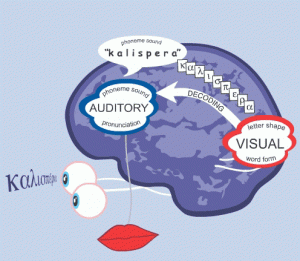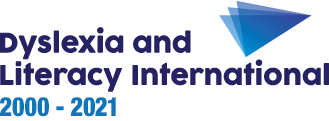Pages in Section 1
It is generally considered that there are three ‘stages’ in establishing the systems for the recognition of words:
- logographic
- alphabetic
- orthographic
The logographic or pre-reading stage
A growing child begins to recognize symbols such as McDonalds:
or the stop sign:
The child does this before having been taught anything about letters, sounds, or how to read.
At this stage, words are being recognized solely by their overall shape and colour(s), and treated like pictures or photos rather than sequences of letters.
The child is not analyzing the letters in these words or making the connection between these letters and their corresponding sounds.
There are two essential requirements for the transition from this logographic stage to the next stage:
- The development of phonological awareness, especially phonemic awarenessThis means becoming aware that spoken words can be analyzed into smaller units, namely syllables, onset-rime units, and, above all, individual ‘sounds’.
‘The discovery of a strong link between the phonological awareness of children and their progress in learning to read is one of the great successes of modern psychology.’ (Goswami and Bryant)
- Grasping the alphabetic principle
This means understanding that in English, the writing system represents the spoken words more or less at the level of the ‘sound’.
For example, the spoken word [ sit ] has three ‘sounds’, and is represented by the three ‘letters’ < s >, < i > and < t >.
This is the reason why phonemic or ‘sound’ awareness, i.e. the awareness that spoken words can be analyzed into individual ‘sounds’ and the building of representations corresponding to these ‘sounds’, is so important to the learning of reading and spelling.
The alphabetic stage leading to the decoding process
From ‘written to spoken’; from ‘spoken’ to ‘written’
By developing representations of phonemes and grasping the alphabetic principle, the child will progressively be able to convert the symbols which represent written words into their corresponding phonemes for reading, and the other way round for spelling.
By developing representations of ‘sounds’ and by grasping the alphabetic principle, the child will progressively become able to convert the symbols which constitute the written words, i.e. the ‘letters’, into their corresponding ‘sounds’ for reading, and to convert the ‘sounds’ of spoken words into ‘letters’ for spelling.
This process entails three steps:
1. The segmentation of the word into the ‘letters’ it is made of, for example:
< c > < a > < t > for < cat >
< n > < igh > < t > for < night>
< n > < eigh > for < neigh >
2. The conversion of each ‘letter’ into its ‘corresponding ‘sound’, for example:
< c > → [ k ] < a > → [ a ] < t > → [ t ] for < cat >
< n > → [ n ] < igh > → [ î ] < t > → [ t ] for < night >
< n > → [ n ] < eigh > → [ â ] for < neigh >
(Remember that [ î ] and [ â ] mean that the vowels are long.)
3. The fusion of the ‘sounds’ generated to make the complete word, for example:
[ k ] – [ a ] – [ t ] → [ kat ]
[ n ] – [ î ] – [ t ] → [ nît ]
[ n ] – [ a ] → [ nâ ]
In short, ‘letters’, the visual form of letters or groups of letters
→ sounds, the elementary units underpinning speech sounds
For this conversion process to happen fast and efficiently, multiple complex connections have to be laid down in the brain.
These connections, which link the visual and auditory regions in the brain, form the decoding system. This system allows the beginning learner progressively to read and spell words.
If you do not know Greek, try to read this word:
< kαλησπερα >
You will find this difficult if you do not know how the ‘letters’ correspond to the ‘sounds’ in Greek. For example, ‘ρ’ is pronounced [ r ] in this language. Only by learning the association between ‘letters’ and ‘sounds’ will you be able to say this word. This will be achieved by the decoding system, which allows us to segment the word, then convert its ‘letters’ into their corresponding ‘sounds’, and finally to assemble the resulting ‘sounds’ to form a sequence which we can pronounce, namely [ kalispera ], which means ‘good evening’.
Look and listen:

The decoding system is an essential tool for beginner learners because it allows them to read the numerous new words they are confronted with and that they have never seen before through the three processes of segmentation, conversion and fusion, just as we were able to read the Greek word < kαλησπερα >. It is also used by fluent readers when they encounter new words.
At this stage, however, the beginning reader is connecting ‘letters’ to ‘sounds’ sequentially (one-by-one), without having developed representations of full words. This is why the decoding system, although essential, is slow and laborious.
Orthographic stage leading to the development of direct access
In the course of time the child will read the same words more and more often and will progressively develop complete and organized orthographic representations of these words; that is, representations of the entire words consisting of sequences of ‘letters’ ordered in a specific way.
These representations will be recorded in the repertory of the visual region of the brain, in the orthographic lexicon.
In parallel, the child will progressively develop complete and organized phonological representations of spoken words, i.e. representations of entire words as sequences of ‘sounds’ ordered in specific ways.
These representations will be recorded in the auditory region, in the phonological lexicon.
See and hear how this works for the word < cat >. (The illustration does not display the phonological representation.)
See and hear how this works:
To illustrate the notions of complete and organized representations, and their importance, suppose that the child progressively develops phonological and orthographic representations of the words:
oat cat was saw
Until the orthographic representations of these words are complete in terms of the identity of their constitutive ‘letters’, the child may read [ cat ] when presented with < oat >, or vice versa, because the first letters of these two words look very much alike.
In the same way, until the orthographic representations of these words are organized in terms of the relative positions of their constitutive ‘letters’, the child may read [ wos ] when presented with < saw >, or vice versa, because these two words share exactly the same ‘letters’ even though these are in different positions in the two words.
When the learner has built complete and organized representations of each of these four words, he or she will be able to read them very quickly and effortlessly, in other words automatically. That is, when presented with any of these words, he or she will automatically access the appropriate orthographic representation in the visual region, which will then transmit the information to the auditory region holding the phonological representation of this word, allowing rapid and accurate recognition and pronunciation.
The process of progressive memorization of the complete representations of words leads to the development of the system for direct access. This system establishes links between the orthographic and phonological representations of words through the development of complex bidirectional connections between the visual and auditory regions in the brain.
In the next animation we can see how this system for direct access works for < cat >.
This system characterises reading in the fluent reader, who dispenses with the decoding system except for rare or unknown words.


